
- +1 (714) 578-6100
Hours Mon - Fri, 07:00 AM - 06:00 PM (Pacific Time)
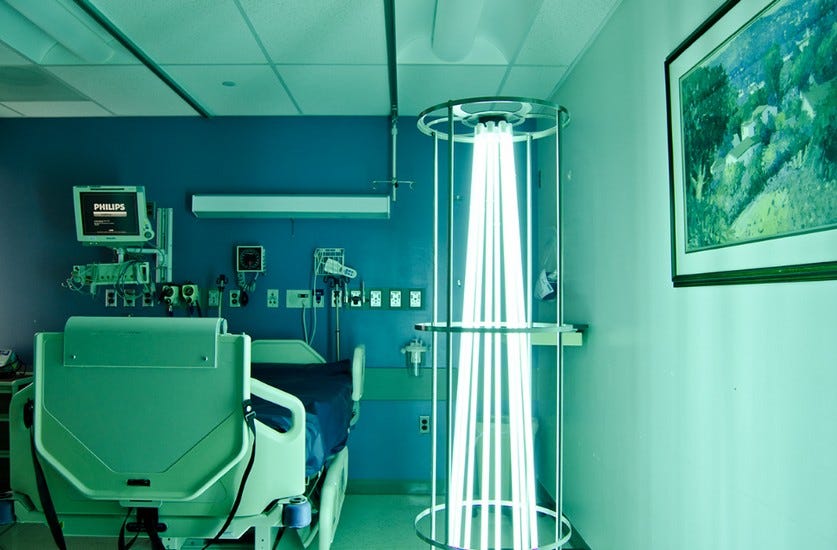
In the age of "superbugs" and antimicrobial-resistant bacteria, modern disinfection protocols will face continued scrutiny. prompting many to consider the integration of Ultraviolet C (UVC) technology. General disinfectants, while effective in many scenarios, exhibit notable shortcomings. In the current realm, confronting hard-to-kill bacteria and spores typically relies on aggressive high-powered sterilants, oxidizers, and denaturants in liquid or vapor forms.
In general environments, the prevalence of Hospital-Acquired Infections (HAIs) are typically associated with opportunistic bacteria such as C. Difficile and Methicillin-resistant Staphylococcus aureus (MRSA), which are largely unphased by retail and even commercial-grade disinfectants. The deficiency, costs, and mechanical labor of chemical cleaning methods necessitate a closer examination of alternative and supplemental approaches.
In focus, ultraviolet light and irradiation are two modern solutions ultraviolet light is a proven method of reducing a wide range of pathogens on environmental surfaces. Importantly, the process does not require long dwell times for the completion of the manual cleaning process, nor does it require the costs, chemical burdens, and physical labor associated with those activities.
Ultraviolet (UV) light exists within a spectrum of light between 10 and 400 nm. UVC light is defined by wavelengths between 100 - 280 nm and is considered the most effective for germicidal purposes. Peak germicidal activity is associated with a peak wavelength of 265 nm. Therefore, wavelengths that fall too far below or too far above the 265 nm range will demonstrate diminished germicidal efficiency.
In between, a distinction is made between wavelengths that fall within three ranges: UV-A, UV-B, and UV-C. Ultraviolet energy is determined by the wavelength value
UV-C is best suited for germicidal activities that require operator-involved environments. Compared to UV-A and UV-B rays, UV-C is less capable of penetrating deeper layers of the skin and eyes, which makes it safer to use in a broader context.
The UV-C spectrum includes two widely adopted light ranges for germicidal equipment. UVC light is emitted at 254 nm, while far-UVC light is emitted at a range of 207 to 222 nm. UVC light is effective against a broad range of pathogens, microbes, and spores. From small-scale applications to total-room decontamination, UVC showcases unique flexibility for the complete eradication of microbes in a dry format. Importantly, it doesn't require liquid-based soaps, detergents, or sterilants to achieve sterile-grade reductions in viable microbial counts.
Far-UVC light is considered "far safer" than standard UVC, albeit, slightly less efficient at the eradication of microorganisms in germicidal UV applications. Because far-UVC can only penetrate the few first micrometers of biological materials, it cannot reach or damage living human cells in the skin or eyes. Far-UVC is more effectively absorbed when it encounters peptides, proteins, and biomolecules, therefore stifling its penetrating power and reducing the risk of harm. Regardless, far-UVC can still penetrate the outer cell walls of extremely small bacteria and viruses, which makes it an effective germicidal mechanism that poses fewer health risks than similar UV technology.
Compared to far-UVC, 254 nm UVC is considered more effective against viruses and pathogens due to its deeper penetration power. However, this extended penetration power requires additional safety measures and limits the use of this technology to unoccupied spaces. The longer 254 nm wavelength is considered more capable of penetrating deeper into human biologics, therefore increasing the risk of damage to living cells and DNA.
254 nm UVC is common for several applications that require widespread decontamination. The most common formats include low-pressure mercury-vapor arc lamps or xenon lamps that emit a broader UV spectrum.
Direct exposure to 254 nm lamps is a serious health risk, and these systems should never be used to disinfect spaces that are occupied by humans. In general, the use of 254 nm in public spaces should be avoided, or otherwise represent a serious risk to the eyes and skin of those in proximity.
For safety purposes, 254 nm UVC lamps are equipped with safety features to mitigate risks, ensuring their responsible use. Terra's UVC lamp solutions, which are designed for deployment in unoccupied rooms, include a motion sensor that deactivates if motion is detected. This is an important safety feature that prevents accidental exposure of unknowing operators such as cleaning or maintenance staff. Other standard safety features include an emergency stop button, a manual reset button, and a remote control push button for added convenience.
At the time of writing this article, research indicates that far-UVC light poses little or no risk of harm when exposed to human skin. Of course, any type of light-emitting device should be used with a common sense approach, and should only be used per the manufacturer's recommendations.
Far UVC light (200–235 nm), particularly around 222 nm, does not penetrate the outer layers of human skin and therefore does not damage the living cells beneath, suggesting it could be safely used in the presence of humans. Research conducted using a 3-D human skin model showed no increase in DNA damage under far UVC light up to 235 nm, while wavelengths between 240–255 nm did cause significant DNA damage. These findings indicate that far UVC light could potentially be used for disinfection in occupied spaces without harming people.
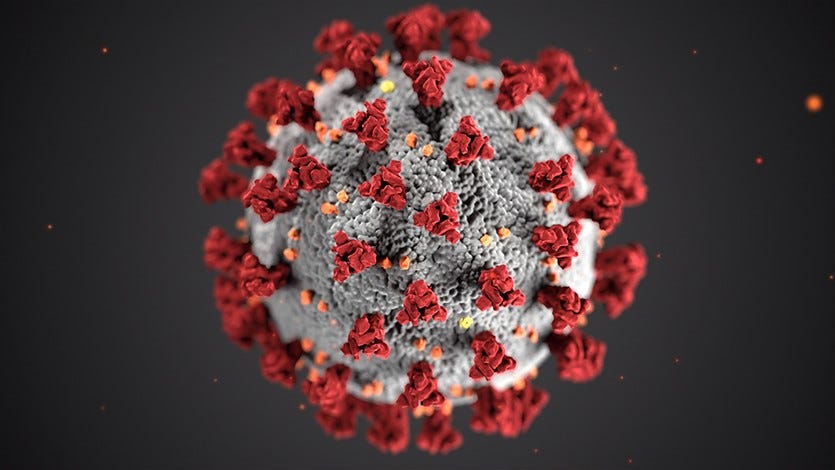
The advantages of integrating UVC into decontamination protocols are multifaceted. Unlike some liquid or aerosol disinfectants that demand additional wipedown procedures, UVC eliminates this requirement, simplifying the disinfection process. Furthermore, it reduces the hazards associated with storing hazardous or flammable chemicals and minimizes the risks of exposure to toxic fumes, spills, or skin contact. This reliability in deployment not only ensures efficient disinfection but also guards against the emergence of super bacteria and antimicrobial-resistant strains.
UVC and infrared irradiation are well suited for combating many common bacteria forms synonymous with healthcare-associated infections (HAIs). Both methods are acutely effective at eradicating certain bacteria. The most infamous of these bacteria are often referred to as "ESKAPE" bacteria, which demonstrate a high level of resistance to antibiotics:
It's crucial to note that UVC requires pre-cleaned surfaces for optimal performance and is not effective against biofilms or subsurface layers, necessitating a holistic approach to decontamination. Additionally, UVC is not capable of sanitizing surfaces or materials that light cannot penetrate. In healthcare environments, aerosolized bacteria and spores are equally opportunistic and difficult to eliminate. Turbulence generated by toilet flushes is one of the most significant contributors of aerosolized pathogens, which easily transfer to garments and circulate to nearby surfaces throughout the environment.
To combat transmission risks associated with garments and apparel, storage cabinets with UVC and High-Efficiency Particulate Air (HEPA) filters offer a dual layer of protection against airborne bacteria. These systems passively filter cabinet air to capture any airborne contaminants, while the UVC modules work to eradicate and remove deposited bacteria on garments or equipment stored in hospitals, clinics, and surgical environments. Beneficially, HEPA filter modules capture any stagnant air in the cabinet, and generate a positive pressure that prevents the invasion of contaminated air to interior items during the opening and closing of the doors.
Additionally, Terra also offers portable HEPA filtration units with UVC modules for facilities that may lack the appropriate air handling systems and pressure controls required for hospital wards that house patients with transmissible diseases. Equally, these systems can also improve protection in environments where even the most benign flu or cold virus could be potentially life-threatening for immunocompromised hosts in ICUs, NICUs, burn units, cancer treatment centers, or in-patient areas where patients are recovering from major surgeries.

Freestanding UV-C Hand Sanitizers are excellent options for promoting hand hygiene in high-visibility, high-traffic environments including clinics, dental offices, long-term care, and in-patient/out-patient care. The UV-C germicidal bulb effectively kills microorganisms at the cellular level, including the complete elimination of ESKAPE pathogens. The device disinfects hands, but also accommodates small objects like cell phones, stethoscopes, remotes, and office supplies, making it a reliable solution for liquid-free microbial control that achieves 99.99% sanitization efficacy.
Dual UV-C lamps ensure broad surface exposure that achieves up to 99.999% efficacy in as little as three seconds for eradicating pathogens like E. Coli, C. Difficile, SARS-CoV-2 (the causative agent of Covid-19), and ESKAPE bacteria strains that contribute Healthcare-Associated Infections (HAI).
Terra Recommends HandyStand UV Sanitizers due to their impressive in-the-box features that include a front-accessible hand slot, allowing users to disinfect their hands conveniently. The variable UV-C dose adjustment and automatic START/STOP functionality ensure precise and efficient sanitization. Underscoring efficiency and longevity, its UV lamps boast an average lifespan of 10,000 hours.
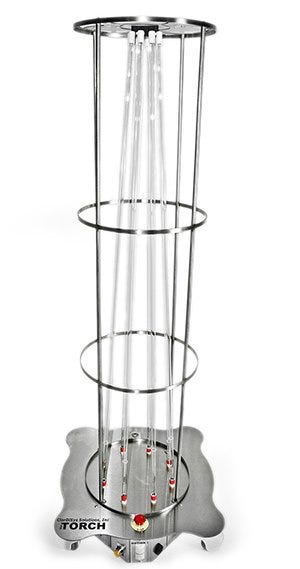
TORCH Portable UV Disinfection Towers allow for a novel, minimal labor solution when decontaminating unoccupied rooms, especially when they encompass irregularly shaped rooms, or host objects and equipment that have unique geometries, semi-porous materials, or liquid-sensitive electronics that object to typical liquid-based cleaners.
Portable UV towers encompass several features that make them viable for laboratories, healthcare facilities, veterinary offices, and pharmaceutical manufacturing facilities alike. With an effective range of 8 feet, these systems allow for 365-degree coverage, including floors and standard ceilings.
In terms of efficacy, the TORCH provides a 99% reduction of MRSA in just 10 seconds and Clostridium difficile in only 1 minute at a distance of 10 feet. The angled arrangement of the bulbs at 4 degrees increases ceiling exposure, while multiple units can be used to eliminate shadow areas during disinfection. disinfection methods. unique equipment, furniture, and medical equipment
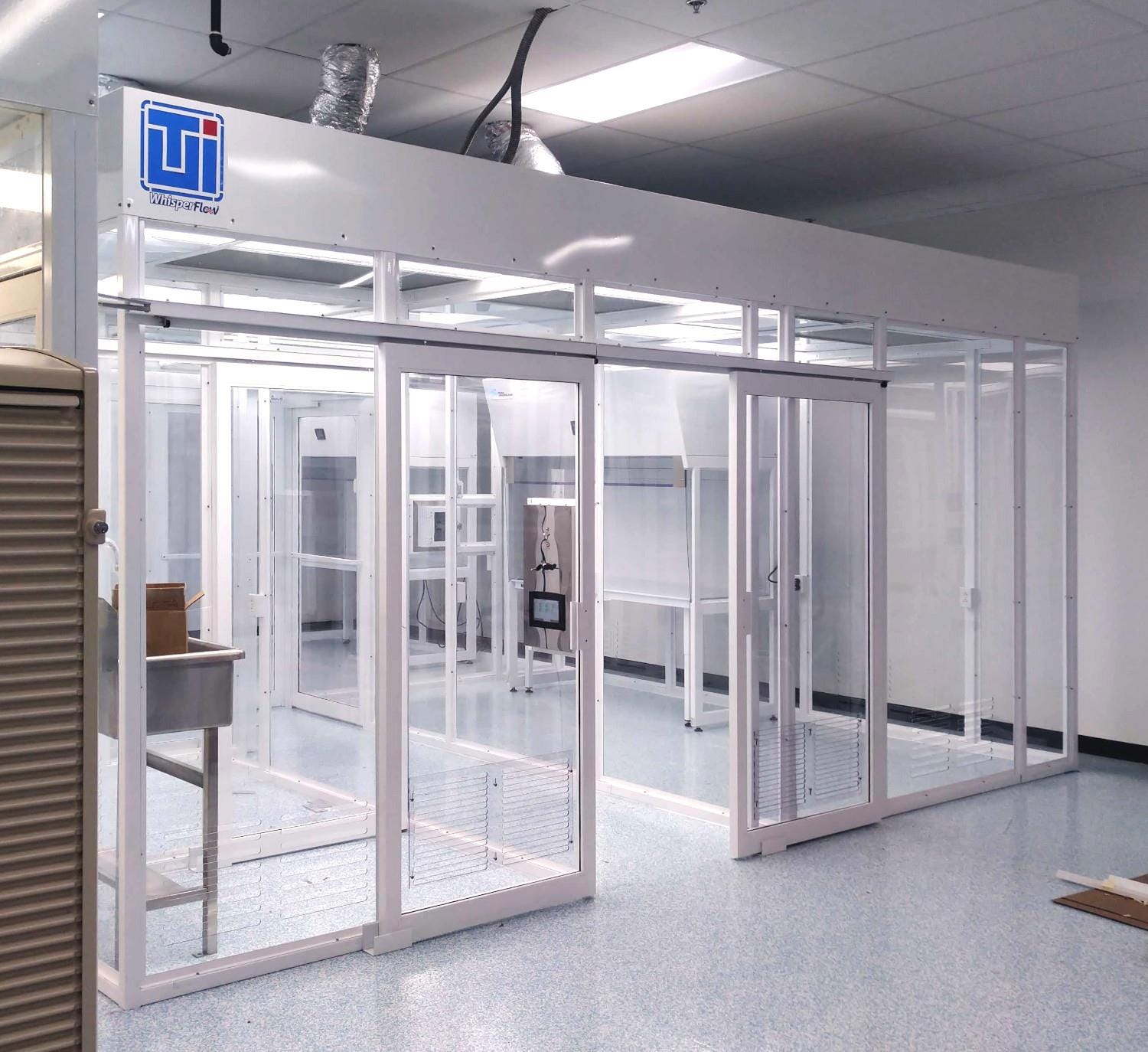
Many FDA-enforced facilities under USP or CGMP guidelines benefit from supplementary UVC treatments, which complement successful outcomes for complete room decontamination in between quarterly or semi-annual cleaning cycles. Specifically, these systems can reduce the need to constantly switch and cycle to alternative cleaning chemicals, which would otherwise be required to irradicate certain types of alcohol-resistant or disinfectant-resistant pathogens, such as spores, and mycobacteria.
TORCH UVC Lamps come equipped with user-friendly features, including 4 built-in motion sensors, a remote starter, and a heavy-duty protective cover. Its open-center design allows for 360-degree radiation of the 8 UVC bulbs, ensuring comprehensive disinfection. Furthermore, it's rated for 16,000 hours of lamp life, making it a sustainable choice. Terra is an authorized distributor of TORCH Portable UV Disinfection by ClorDiSys.
Germicidal infrared radiation (IR) lights are common fixtures in laboratory, research, and academic environments that require a high degree of sterility assurance for reliable results. From a productivity standpoint, benchtop germicidal IR lights allow for high-temperature sanitation of apparatus that are sensitive to UV light or chemical sterilants. Leveraging infrared heating technology, it accomplishes the eradication of microorganisms in 5 to 7 seconds.
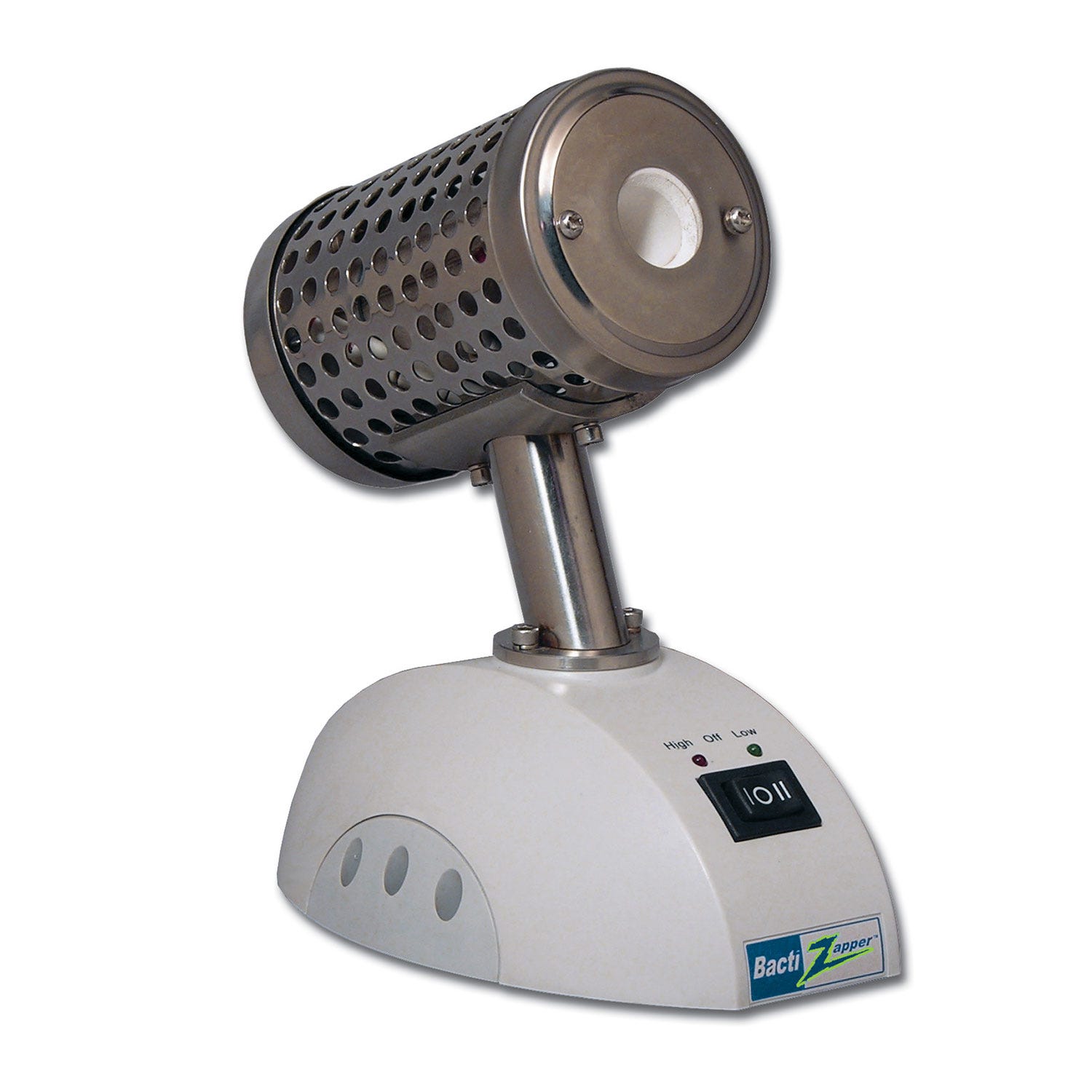
For laboratory sterilization, Terra recommends Benchmark Scientific's BactiZapper Sterilizers. These systems generate a gasless, flameless heat source that supports sterilization for use with platinum inoculating loops, needles, glass tube/pipette mouths, and various metal & borosilicate glass instruments. Sterilization is accomplished through infrared heat without the potential of spattering or spreading microorganisms during the process.
This sterilizer is versatile for both anaerobic and aerobic chambers in laboratory settings and is commonly used for sanitizing platinum inoculating loops, metal instruments, and borosilicate glass instruments, ensuring hygiene in critical laboratory processes. Optional accessories, such as the loop holder and slide dryer attachment, enhance functionality, providing solutions for holding small items during sterilization and drying glass laboratory slides efficiently.
In conclusion, the limitations of general disinfectants, particularly in the face of evolving microbial challenges, highlight the need for innovative solutions. UVC technology emerges as a potent and versatile tool, offering a safer, more efficient, and reliable means of disinfection across various applications. Its integration into decontamination protocols holds significant promise, ushering in a new era of pathogen control and safety in diverse professional settings.
Terra Universal is the leading expert in the design and fabrication of ISO rated cleanrooms, furnishing and supplies.
Call (714) 459-0731
